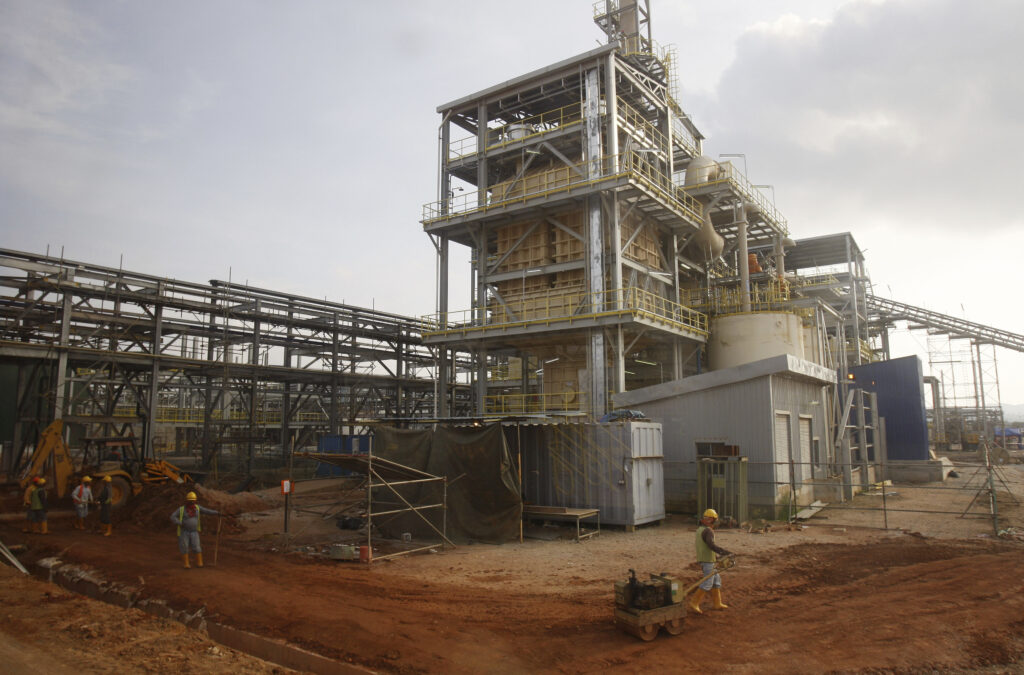KUALA LUMPUR, Malaysia — In their quest to break China’s chokehold over rare earth metals, the United States and its partners increasingly see an answer in a 15-year-old processing facility in central Malaysia.
The only major rare earths refinery outside China, it is operated by Australian firm Lynas, financed by a Japanese state-owned company, and will soon add a South Korean-developed “super magnet” factory next door. It represents the kind of allied joint venture that Washington wants to see replicated across the world to weaken China’s grip over processed rare earths, which are needed in everything from missiles to pacemakers.
“We’re going to get out from under the sword that the Chinese have over us,” Treasury Secretary Scott Bessent said this month. “And this time, we have rallied the allies.”
China controls 70 percent of rare earth mining and 90 percent of processing, with near-total dominance over processed heavy rare earths such as dysprosium, which are critical in defense technologies. It has exerted this as leverage twice this year, imposing sweeping export restrictions that sent companies across the globe scrambling.
The U.S. is pouring billions into rare earth capabilities on American soil, including by financing a new Lynas plant in Seadrift, Texas. But progress on these projects has been halting, with Lynas sayingin August there is “significant uncertainty” whether its Texas plant will go ahead. Consensus is growing in Washington that bigger, swifter strides could be made in creating trustworthy supply chains abroad.
The Lynas refinery in Malaysia is a “torch bearer” for this approach, said David Merriman, London-based research director at Project Blue, a critical minerals consultancy.
Since 2012, the industrial complex in the forested state of Pahang has been taking in light rare earth ores from a mine in Western Australia and separating them into elements needed in products like electric vehicles and wind turbines.
In May, it became the first commercial refinery to process heavy rare earths outside China. And in October, it announced a $117 million expansion as well as new partnerships with two magnet makers — the South Korean JS Link and the U.S.-based Noveon Magnetics, both of which say they will supply U.S. defense systems.
According to Lynas’s investor reports, more than 90 percent of employees at its plant are Malaysian and an increasing share of its supply chain is sourced domestically. This makes Malaysia a leading option for a rare earths refining hub not controlled by Chinese interests, say analysts and Western officials.
“Malaysia’s got really, really good capability now, in its people and in the supply chain, to play a part of global processing capability,” said Danielle Heinecke, Australia’s high commissioner to Malaysia.
The U.S. — which has signed rare earth agreements with Australia and Japan — is backing this trend.
During President Donald Trump’s visit to Kuala Lumpur last month, the U.S. secured commitments from Malaysia to grow its rare earths sector “in partnership with U.S. companies” and not to restrict exports to the U.S. of rare earth products. American investors are flocking here to examine what Lynas has done. The Defense Advanced Research Projects Agency, the innovation arm of the U.S. military, recently dispatched experts to assess what kind of tech could be useful.
But these ambitions will not go unchallenged.
China’s leaders have spent more than a decade entrenching their influence in Malaysia’s rare earths sector, pressing Malaysian miners to funnel ores to Chinese refineries and, in some instances, intervening directly to ensure they do not flow into competing supply chains, according to U.S. and Malaysian officials, as well as people working in Malaysia’s rare earths sector. Some spoke on the condition of anonymity because they had not been authorized to discuss the sensitive industry.
Recently, Chinese suppliers stopped providing spare parts for Chinese-made machines in the Lynas facility, forcing the company to build more expensive alternatives, these people said. Lynas did not respond to requests for comment but the company’s chief executive, Amanda Lacaze, last month warned that Chinese constraints on equipment were already starting to inflict “cost penalties.”
The U.S. has not yet fully appreciated China’s ability to counteract challenges to its dominance, including by driving specific refineries out of business, President Joe Biden’s former national security adviser, Jake Sullivan, said on the ChinaTalk podcast this week. “We need a much more aggressive strategy,” he said.
China’s ministries of foreign affairs and commerce did not respond to requests for comment.
Malaysian leaders stress that their recent deals with the U.S. do not preclude cooperation with China, including ongoing negotiations for a Chinese refinery here. While Lynas has signed an agreement with the Malaysian state of Kelantan to explore its rare earth deposits, the Chinese state-owned company Xiamen Tungsten has signed a similar deal with the state of Kedah.
“We are not trying to build an alternative supply chain,” Tengku Zafrul Abdul Aziz, Malaysia’s investment, trade and industry minister, said in an interview. “Alternative supply chain means we want to allow non-Chinese to compete with the Chinese supply chain. No — we are inviting the Chinese to come here as well.”
‘A call from China’
China wants to cultivate external sources of rare earth mineral ores, and Malaysia, which has an estimated 17 tons of deposits, is a key target.
In 2022, a mining company jointly owned by Malaysian and Chinese shareholders, MCRE Resources Bhd, set up shop in the state of Perak. MCRE was the first in the country to use Chinese-provided tech for “in situ leaching” — a method that has been shunned by many Western miners because it involves pouring chemicals directly into the ground.
Malaysian officials initially asked MCRE to send its ore to the Lynas facility so processing could be done domestically, said Nik Nazmi Nik Ahmad, who was serving at the time as Malaysia’s natural resources and environmental sustainability minister. But “they got a call from China saying that that’s not going to happen,” Nik Nazmi said. “And that was it.”
According to MCRE’s disclosures to investors, all of its product has been sold so far to Chinalco Guangxi Nonferrous Rare Earth, a subsidiary of the state-owned China Rare Earth Group. When Malaysia imposed an export ban on rare earth ores last year to spur downstream investment, MCRE was given the sole exemption to continue exporting to China.
Working with the Chinese was a commercial decision, said Lim Wei Hung, executive director of Southern Alliance Minerals, the Malaysian company that owns a 40 percent stake in MCRE. When the company began operating, it wasn’t clear if Lynas was able to refine the types of heavy rare earths being dug up. The Chinese did, which meant they could guarantee offtake, he said.
Now, MCRE is inextricably intertwined with China’s supply chain. Day-to-day operations are overseen by Su Yunchun, a Chinese national whose firm, Qingdao Jifeng Investment, holds a 36 percent stake in MCRE, company disclosures show. Virtually all equipment and chemical inputs are from China, Lim said, and the company cannot risk losing that supply.
“The government needs to understand the geopolitical reality,” Lim said. “We don’t have full control.”
‘Black box’ transfers
Some in Malaysia see the MCRE mine as a cautionary tale about the risks of integrating with China’s supply chain.
“Beijing will call the shots in the long term,” said Collins Chong, a security analyst at the University of Malaya.
U.S. and Australian officials are also telling Malaysia that, if it wants to move down the supply chain to process as well as mine rare earths, it cannot rely on China. The export regime laid out by China’s Commerce Ministry this year shows Beijing intends to keep those capabilities at home, the officials say. Many analysts agree.
But not all Malaysian leaders are convinced.
The last two times Chinese leader Xi Jinping met Malaysian Prime Minister Anwar Ibrahim, Xi said China would work with Malaysian government-linked companies on processing, officials here told The Washington Post.
Howard Lee, a Malaysian legislator who chairs a parliamentary caucus on minerals, said Chinese officials are open to setting up a refinery in Malaysia that involves “minimal, if not no, transfer of know-how.”
In exchange for minerals, China could share tech under “black box” arrangements, said Rare Earth Industry Research, a Chinese research group. “Chinese engineers can be dispatched to guide operations at Malaysian plants … similar to China’s model in African copper mines,” it said.
Chang Lih Kang, Malaysia’s Minister of Science, Technology and Innovation, said the country doesn’t want cooperation “that is purely extractive.” Chinese authorities, he added, “have to choose whether to work with us in processing or ignore us and push us to the other side.”
But Lee said he’s not sure Malaysia can afford to turn down what China is willing to offer.
Lynas has so far only developed the ability to process two heavy rare earths — dysprosium and terbium — at commercial scale. Lee listed others: gadolinium, ytterbium, lutetium.
“How many companies outside China can process them?” he asked. “None.”
Biggest enemy
The tussle over Malaysia’s rare earths sector formed the backdrop this month for one of the biggest international conferences of rare earth miners, executives and investors. In an upscale Kuala Lumpur hotel, they grappled with what was needed to overcome China’s dominance.
A Canadian engineer lamented there were exponentially more rare earths technicians in China than in the rest of the world combined. A British consultant said the only alternatives to Chinese equipment that he’d seen were at least three times the price.
“It’s brutal — it’s so expensive,” said Nick Myers, chief executive of Phoenix Tailings, a Massachusetts rare earths start-up, which last month announced it had opened the first rare earth metallization facility in the U.S. with no Chinese inputs.
If governments want rare earths outside China, Myers said, they’ll have to roll out funding. He pointed to Lynas. The plant in Malaysia was created after China restricted rare earths to Japan in 2010, prompting a state-owned Japanese company to invest $250 million to build a refinery outside China.
But money — even lots of it — can only do so much, said Lim, the Malaysian miner. From prospecting to extraction, establishing a mine can take a decade, he said. And that’s just the first step in a long, convoluted supply chain that China has spent four decades perfecting.
As he sees it, the biggest enemy to Washington’s rare earths ambitions is not China, Lim said. “It’s time.”
Shepherd reported from Singapore. Lyric Li in Seoul contributed to this report.
The post U.S. rare earth ambitions center on Malaysia. But China’s already there. appeared first on Washington Post.




